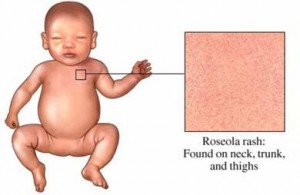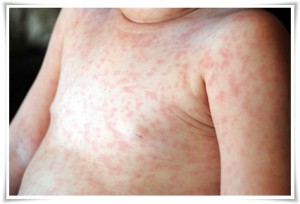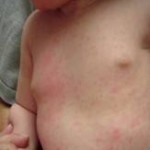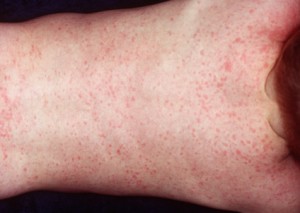Is your baby suffering from pinkish-red rashes on the skin following a fever? The cause may be nothing other than Roseola Rash, a particular medical syndrome. Read on to know Roseola Rash description, causes, symptoms, diagnosis and treatment.
What is Roseola Rash?
Page Contents
- 1 What is Roseola Rash?
- 2 Roseola Rash Symptoms
- 3 What does Roseola Rash look like?
- 4 Roseola Rash in Adults
- 5 Roseola Rash Causes
- 6 How long does Roseola Rash last?
- 7 Is Roseola Rash Contagious?
- 8 Roseola Rash and Pregnancy
- 9 Pictures of Roseola Rash
- 10 Roseola Rash Diagnosis
- 11 Roseola Rash Treatment
- 12 Roseola Rash Home Remedies

Picture 1 – Photo of Roseola Rash
Source – thirdage
Roseola Rash is a medical condition characterized by viral illness in very young children. The disease mainly affects kids who are aged between 6 months and 2 years. The viral illness gives rise to high fever in patients that lasts for several days. Rashes appear over the skin as soon as the fever starts to subside.
The condition is known by many other names such as Exanthema Subitum, Sixth Disease, Three-Day Fever, Baby Measles, Roseola Infantum, Rose Rash of Infants or simply Roseola.
Roseola Rash Symptoms
Roseola Rash patients can show a number of health abnormalities like :
Respiratory Disorder
Sufferers of this disorder normally have a mild upper respiratory disorder. Breathing difficulties are usually the first sign of this disease. Upper respiratory disorder appears in patients of Roseola Rash before fever.
High Fever
This is followed by high body temperatures that can go over 103 degree Fahrenheit. The fever persists for about 7 days. Roseola Rash and fever are common in many children.
Runny Nose
The patient has nasal discharge much like in common cold or fever.
Mood Irritability
During fever, the child may appear irritable or fussy. Mood irritability is one of the various symptoms of Roseola Rash.
Loss of Appetite
The condition may cause reduced appetite in the child. The sufferer loses the inclination to have food due to this disease.
Swollen lymph Nodes
The patient also suffers from inflammation in the lymph nodes in the neck.
Convulsions
Fever often leads to convulsions (febrile seizures) in the affected infant. Convulsions lead to fainting, jerking of limbs, face and loss of bladder control.
Rashes
In most cases, the fever goes away suddenly. This is immediately followed by an outbreak of rashes on the body. Roseola rashes are mainly visible on the face, neck, limbs and on the trunk.
Vomiting
In rare cases, there may be other physical symptoms arising from Roseola Rash and vomiting is one of them. Because of high fever in Roseola Rash toddlers may vomit. A Roseola Rash baby can also suffer from stomach ache, sore throat and diarrhea.
What does Roseola Rash look like?

Picture 2 – Roseola Rash Photo
Source – mommysinfodose
Roseola Rashes appear as small red spots on the skin. These turn pale under pressure from finger tips. Unlike many other rashes that are common in children, Roseola Rashes are neither irritating nor itchy. Only in rare cases Roseola Rash itchy symptoms are found.
Roseola Rash in Adults
In Roseola Rash infants are the main victims. In most cases of Roseola Rash children are seen to be sufferers. But you may also find the condition affecting adults and teenagers. Fortunately, such cases are rare and only a few grown-ups are seen to be affected by this disorder.
Roseola Rash Causes
As aforesaid, Roseola Rash is a viral illness. Virus agents like Human Herpesvirus 6 (HHV-6) is primarily responsible for this disease. Rarely, it is also caused due to an infection by Human Herpesvirus 7 (HHV-7).
How long does Roseola Rash last?
You will normally find Roseola Rash lasting a week or a maximum of ten days. The fever normally lasts from 3-7 days. This is followed by the occurrence of rashes. In normal circumstances, rashes go away in a few hours or in about two or three days. Usually, Roseola Rash duration is not more than ten days.
Is Roseola Rash Contagious?
This is a transmissible condition. It spreads from person to person through the fluid coming from the nose and throat of the infant. The fluid is expelled as tiny drops from the nose and throat of sufferers when they talk, sneeze, cough or laugh. People who breathe these drops can become infected.
Washing hands is very necessary after touching objects such as handkerchief and clothes of Roseola Rash sufferers. These objects may contain drops of infectious fluid and transmit the disease from sufferers to healthy persons.
Curiously, kids affected with the disease do not spread it in usual cases. Rather, people who have not yet developed Roseola Rash symptoms may act as carriers of the condition.
Roseola Rash and Pregnancy
Pregnant women who are exposed to Roseola Rash rarely get affected by this disease. The condition also causes very few congenital infection cases. This is because most women are already exposed to this virus during their childhood. But if a pregnant woman is exposed to the virus for the first time in her life, complications may arise.
Roseola Rash in pregnant women can be risky for the fetus. If the virus affects a pregnant woman during the first trimester, miscarriages may occur. In later stages of pregnancy, it can give rise to birth defects.
Pictures of Roseola Rash
If you have not come across any Roseola Rash patient, you may not have an idea how the condition looks like. Here are some useful Roseola Rash photos. These Roseola Rash images will help you know about the appearance of the disease. The Roseola Rash pics show the common skin regions where the eruptions are seen.

Photo 3 – Picture of Roseola Rash
Source – google

Image 4 – Roseola Rash Image
Source – assets.babycenter
Roseola Rash Diagnosis
The symptoms of Roseola Rash are very similar to many other infectious diseases. It thus becomes very difficult for doctors to make an accurate detection of the disorder.
Doctors normally begin diagnosis of the condition by making a physical examination. This is followed by blood and urine tests to check the type of infection in the sufferer.
The medical history of the sufferer is also taken into account for a proper detection of the condition.
Roseola Rash Treatment
This is usually a mild condition and hence no treatment is needed. But if the affected person suffers from high fever all of a sudden, medical assistance is necessary. Doctors normally reduce the body temperature with medicines like Ibuprofen and Acetaminophen.
Skin rashes do not require any treatment. Doctors advise a number of home remedies to help quick recovery of the infant. Aspirin is not given to children younger than 20 years. In infants and teens, aspirin increases the risk of Reye Syndrome.
Roseola Rash Home Remedies
The home remedies for Roseola Rash are :
Rest
The disease causes fatigue in most sufferers. Hence, children suffering from the disorder are advised to take rest for a few days for complete recovery.
Fluid Intake
Sufferers are encouraged to increase their fluid intake. Having fluids like water, lime soda, ginger ale and electrolyte solution can help clear impurities out of the bloodstream and aid in a faster recovery of the patient.
Healthy Diet
Children with low immunity should follow a healthy diet plan to boost their immunity. Parents of sufferers are advised to provide healthy foods to their kids to prevent outbreak of this disorder.
Roseola Rash is usually a harmless infection and seldom leads to any health complication. Getting medical help is necessary only if the fever and rashes get worse. Medical treatment is also necessary if the rash persists for more than one week. Taking early medical assistance will help you avoid all future health complications and assure the good health of the sufferer.
References:
http://en.wikipedia.org/wiki/Exanthema_subitum
http://www.wisegeek.com/what-is-roseola-infantum.htm
http://www.healthy-skincare.com/roseola-rash.html
http://www.medicinenet.com/roseola/article.htm
http://kidshealth.org/parent/infections/skin/roseola.html

How do I now if the rash is Roseola or its something he ate
can you get roseola more than once?